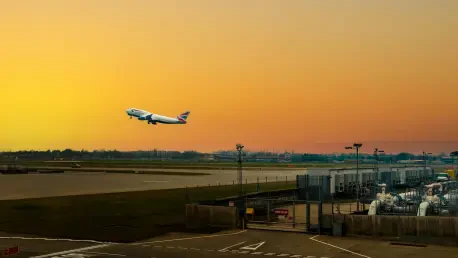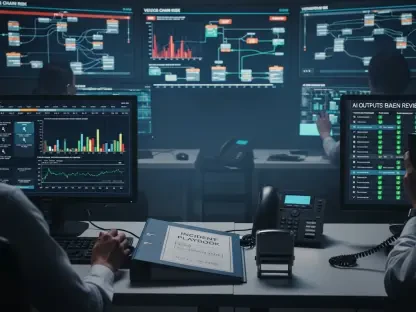Imagine a bustling morning at Heathrow Airport, one of the world’s busiest aviation hubs, suddenly grinding to a halt—self-service kiosks offline, passengers stranded in endless lines, and flights delayed across multiple continents due to a recent cyberattack. This isn’t a hypothetical scenario but a stark reality following an attack that originated from a third-party system, exposing deep vulnerabilities in the aviation industry’s supply chain. This roundup dives into diverse perspectives from industry experts, cybersecurity professionals, and aviation stakeholders to unpack the implications of this breach, explore the operational and data risks it revealed, and gather actionable strategies to safeguard against such threats in a hyper-connected world.
Unpacking the Breach: Expert Views on a Wake-Up Call
The cyberattack at Heathrow, stemming from a compromise in Collins Aerospace’s MUSE platform—a critical passenger processing system—sent shockwaves through the aviation sector. Industry analysts emphasize that the breach disrupted not just Heathrow but also airports in Brussels and Berlin, highlighting how a single vendor flaw can paralyze global operations. Many point out that this incident serves as a critical reminder of the fragility of interconnected digital systems, urging a reevaluation of dependency on third-party platforms.
Cybersecurity specialists note that the high visibility of the disruption, with manual check-ins and delayed flights, amplified public frustration, even though core safety systems remained unaffected. Their consensus is that such events often overshadow the deeper, systemic issues in supply-chain security. Opinions vary on whether the industry is prepared for similar attacks, with some arguing that current defenses are reactive rather than proactive, leaving room for recurring chaos.
A recurring theme among experts is the need to address both immediate fallout and long-term risks. While some focus on the operational snags, others stress the silent danger of data exposure as the more pressing concern. This roundup will explore these dual challenges, drawing on varied insights to shed light on recovery efforts, systemic vulnerabilities, and the path forward for aviation security.
Ripple Effects of a Supply-Chain Cyber Strike: Diverse Perspectives
Operational Chaos at Heathrow and Beyond
The immediate impact of the cyberattack painted a vivid picture of disorder—crippled kiosks, hand-written luggage tags, and frustrated travelers facing hours of delays at Heathrow and other affected airports. Aviation insiders describe the scene as a logistical nightmare, with staff scrambling to manage passenger flow through outdated manual processes. Many agree that while flight schedules are stabilizing, the public’s perception of reliability has taken a significant hit.
Some industry voices argue that the visibility of these disruptions often masks underlying flaws in aviation’s reliance on third-party systems. They suggest that the chaos, though temporary, reveals a lack of robust contingency plans for such widespread outages. Differing opinions emerge on whether airports should prioritize redundant systems over streamlined efficiency, with a few experts cautioning that cost-cutting measures often leave critical infrastructure exposed.
Another angle brought forward by operational analysts is the cascading effect across international hubs. They highlight that a breach in one vendor’s system can disrupt multiple regions simultaneously, raising questions about global coordination in crisis response. This diversity of thought underscores the complexity of managing such incidents in a sector where time is of the essence.
Hidden Perils: Data Exposure and Long-Term Threats
Beyond the visible chaos, a graver concern looms large among cybersecurity experts—the potential compromise of passenger and staff data through the breached platform. Many warn that stolen information could be exploited for identity theft, fraud, or even sold on illicit markets, posing risks that outlast airport delays. This threat, though less tangible, is seen as a ticking time bomb for both individuals and airlines.
A contrasting viewpoint among data security professionals focuses on the challenge of quantifying this risk. Some argue that without concrete evidence of data misuse, resources might be misallocated toward operational recovery rather than long-term protection. Others counter that the mere possibility of exposure demands immediate action, such as enhanced encryption and monitoring, to prevent future exploitation.
The tension between addressing public-facing disruptions and silent data threats is a hot topic. Experts in risk management emphasize that rebuilding trust with travelers hinges on transparent communication about data safeguards. Their insights suggest that balancing these dual priorities will be a defining challenge for the aviation industry in the coming years.
Supply-Chain Weaknesses: A Growing Concern in a Connected Era
Supply-chain attacks are increasingly viewed as a stealthy entry point for cybercriminals, with many industry leaders pointing out that a single vendor breach can ripple across an entire network of airports. This incident has fueled discussions about the aviation sector’s over-reliance on interconnected systems, where efficiency often comes at the cost of security. Some experts advocate for stricter vendor oversight as a non-negotiable step forward.
Regional differences in response capabilities add another layer of complexity, according to global cybersecurity consultants. They note that while some airports have robust in-house defenses, others depend heavily on external providers, creating uneven vulnerabilities. A few suggest that emerging tools, such as real-time threat detection, could bridge these gaps, though opinions differ on the feasibility of widespread adoption given budget constraints.
Challenging the notion that internal security is sufficient, many voices call for a fundamental rethink of digital interdependence. They argue that the aviation industry must map out every link in its supply chain to identify weak points. This perspective pushes for a shift from isolated defenses to a collaborative, industry-wide approach to mitigate risks in an increasingly digital landscape.
Recovery and Risk Management: Strategies Post-Crisis
In the aftermath of the attack, recovery efforts have combined technical fixes with operational workarounds, as described by aviation recovery specialists. Teams are isolating malware, updating software, and scrutinizing logs to trace the breach’s origin, while manual processes keep passenger handling afloat. Some experts highlight the role of government collaboration in these efforts, stressing that public-private partnerships are crucial for thorough investigations.
Differing views emerge on the role of cyber insurance in managing such crises. While some risk analysts see it as a vital safety net, others caution that policies often fall short in covering cross-border supply-chain losses. They suggest revisiting contract structures to better allocate risks between airports and vendors, a perspective that has gained traction in recent industry forums.
Looking ahead, many believe this incident could catalyze lasting changes in cybersecurity practices. Speculation abounds on whether it will lead to stricter vendor accountability or mandatory resilience standards. Insights from policy advisors indicate that redefining preparedness through shared responsibility might be the most effective way to prevent similar disruptions down the line.
Key Takeaways from the Cyber Crisis: Collective Wisdom
Synthesizing the range of opinions, a clear picture emerges of the devastating potential of supply-chain breaches, capable of halting operations across multiple hubs from a single failure point. Experts unanimously agree that the dual threat of operational paralysis and data theft poses a unique challenge, with some prioritizing immediate recovery and others focusing on the enduring risks of compromised information. This balance of concerns reflects the multifaceted nature of modern cyber threats.
Practical recommendations for aviation stakeholders include conducting rigorous vendor audits to ensure compliance with security standards. Enhanced contingency planning is another widely supported measure, alongside investment in real-time threat detection to catch breaches early. These actionable steps are seen as essential for building resilience against inevitable future attacks.
Collaboration stands out as a recurring theme, with many advocating for industry-wide security frameworks to address shared vulnerabilities. Stakeholders are encouraged to push for standardized protocols that can protect against cascading failures. These strategies aim to empower not just airports but also travelers and related organizations to navigate risks more effectively.
The Path Forward: Securing Aviation Against Hidden Dangers
Reflecting on the insights gathered after this significant cyberattack, it became evident that the aviation industry had faced a pivotal moment in addressing supply-chain vulnerabilities. The diverse perspectives highlighted a shared urgency to strengthen defenses against both visible disruptions and invisible threats like data exposure. The discussions underscored that no single entity could tackle these challenges in isolation.
Looking back, the consensus pointed toward actionable next steps, such as fostering tighter collaboration between airports, vendors, and regulators to establish robust security benchmarks. Industry leaders were encouraged to explore innovative solutions like AI-driven threat monitoring to stay ahead of evolving risks. These measures aimed to rebuild trust and ensure smoother operations in the face of future crises.
Beyond immediate fixes, the incident prompted a broader consideration of how aviation could adapt to a digital-first world. Experts suggested delving into cross-sector learning, drawing from industries like finance that have navigated similar supply-chain threats. This approach opened new avenues for resilience, ensuring that the lessons learned would continue to shape a safer, more secure future for global travel.









